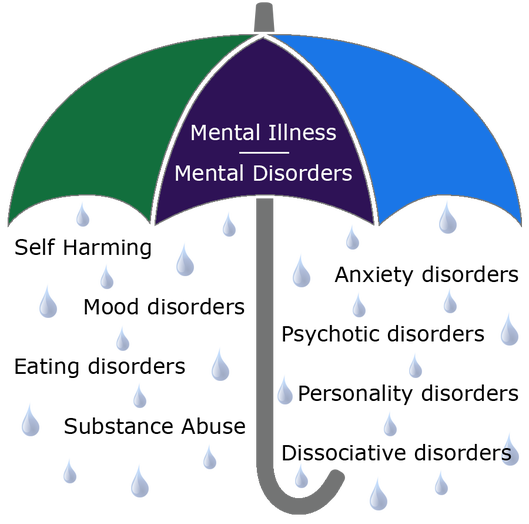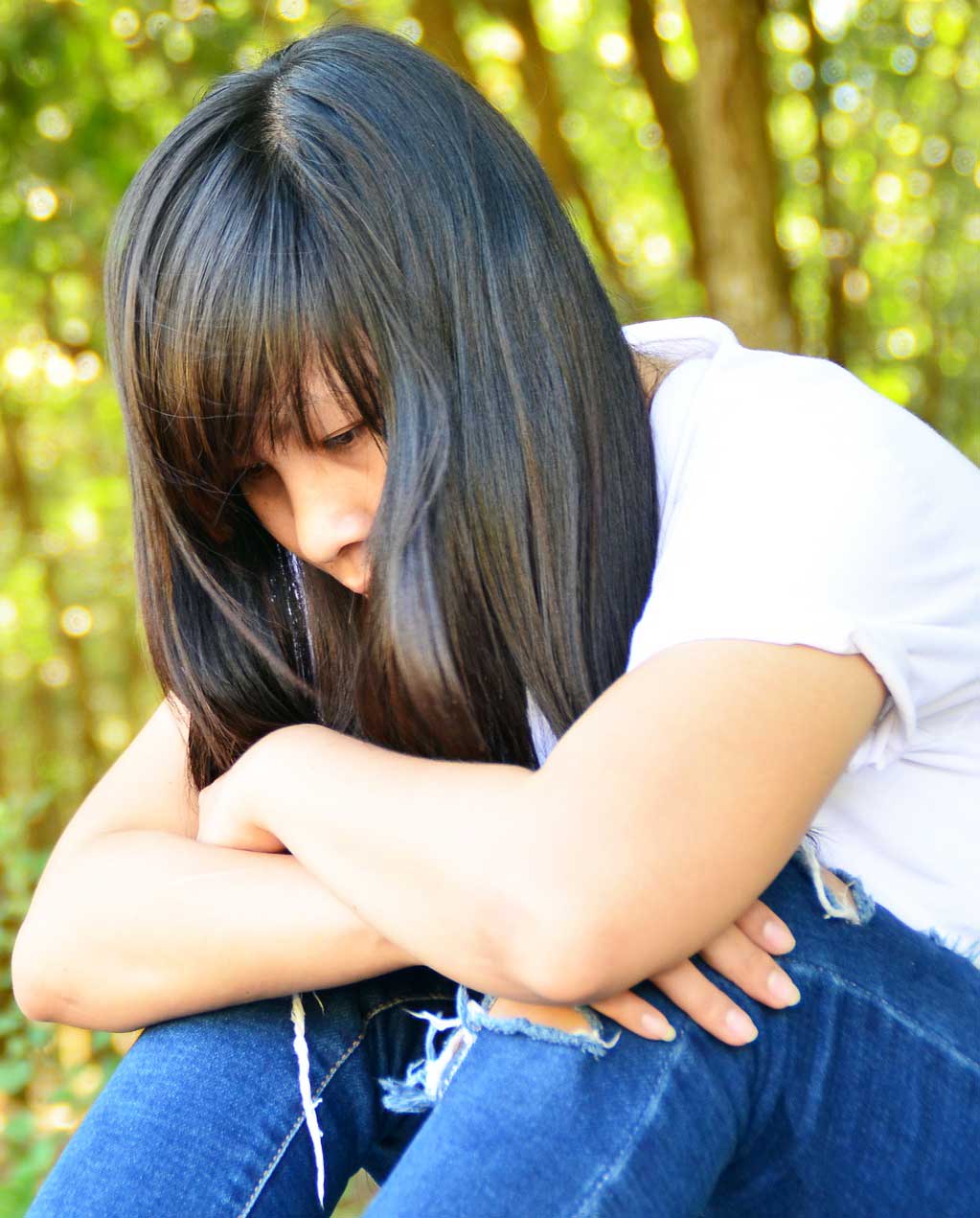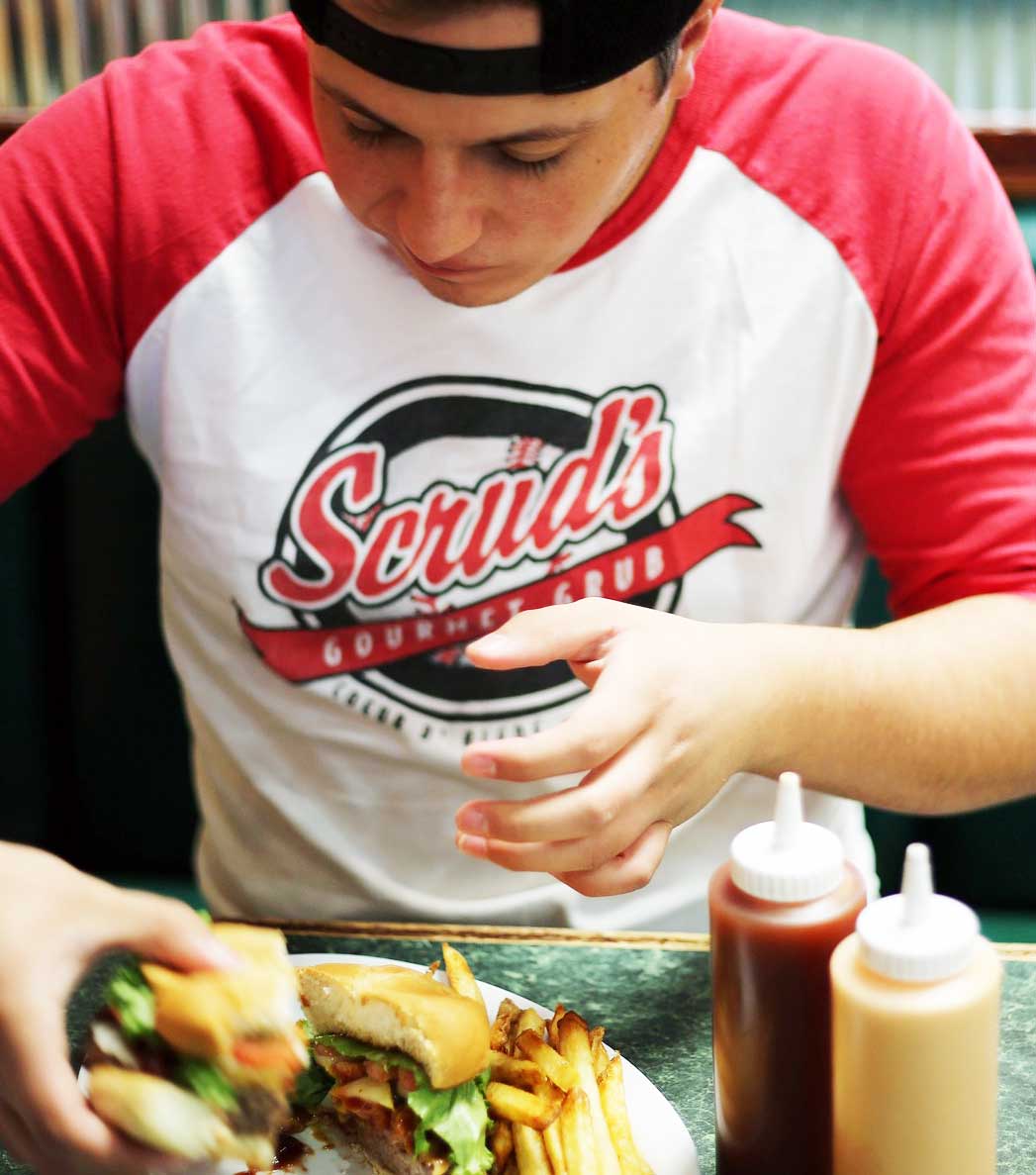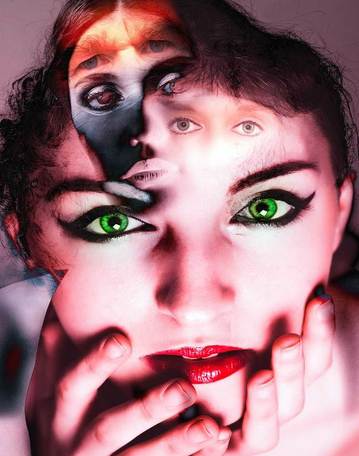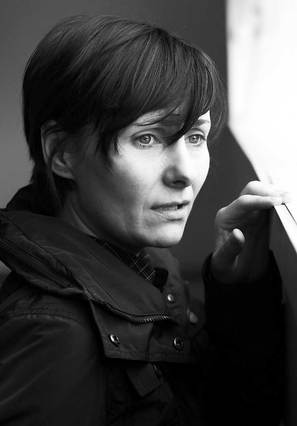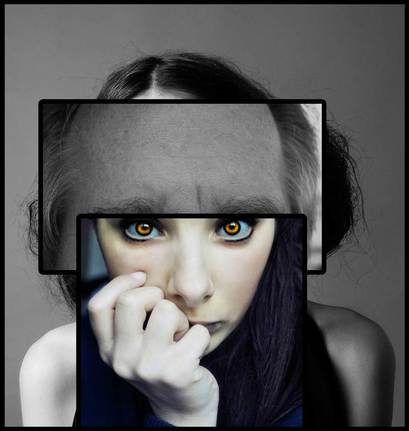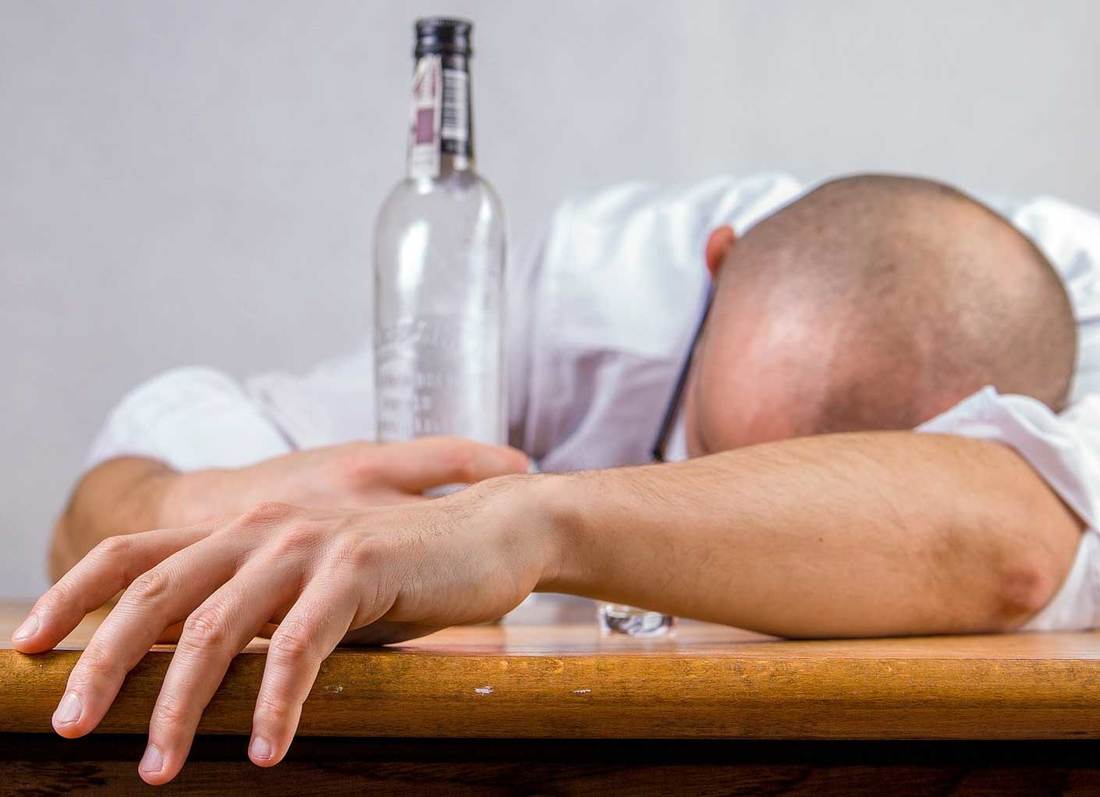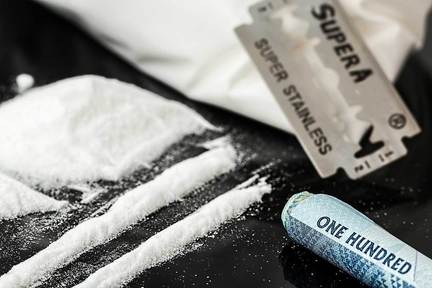Other Mental Disorders
The term 'mental disorder' and 'mental illness' are used interchangeably, but these two terms are actually the umbrella terms for other disorders which can then be divided even further.
Furthermore, it gets complicated because some people refer to some of these disorders as emotional disorders, and sometimes personality disorders can be used interchangeably with behavioural disorders.
Sounds very complicated, hey?
Let's have a look at this in an easier concept:
Furthermore, it gets complicated because some people refer to some of these disorders as emotional disorders, and sometimes personality disorders can be used interchangeably with behavioural disorders.
Sounds very complicated, hey?
Let's have a look at this in an easier concept:
MOOD DISORDERS
Depression: Depression is characterised by feelings of extreme sadness, hopelessness and just an all-round very low feeling. As with all mental disorders, the feelings don't go away and the symptoms can range from mild to severe.
In mild to moderate cases, the person can still relatively get on with their life and do what needs to be done each day, but they just feel really sad all the time. In more extreme cases, depression can really start to affect a person's life.
They feel like giving up on life and can feel suicidal. Depression symptoms range extensively from sleep disturbances, to appetite changes, to moodiness, tearfulness, having no interest in anything and seeing the negative in everything.
For more information on depression and where to get help, please go to Helpful Resources
In mild to moderate cases, the person can still relatively get on with their life and do what needs to be done each day, but they just feel really sad all the time. In more extreme cases, depression can really start to affect a person's life.
They feel like giving up on life and can feel suicidal. Depression symptoms range extensively from sleep disturbances, to appetite changes, to moodiness, tearfulness, having no interest in anything and seeing the negative in everything.
For more information on depression and where to get help, please go to Helpful Resources
|
Bipolar Disorder: Bipolar Disorder can also be referred to as manic depression. It is characterised by sudden changes in mood, whereby the person has episodes of extreme happiness, mania, sadness or extreme depression.
Their mood can change between any of these and it is very distressing for both the sufferer and the people who are close to them. Symptoms include manic episodes which can range from elation and extreme friendliness to extreme ambition, high energy, doing reckless things and being extremely talkative. Sometimes some symptoms can display themselves as psychotic, whereby the person can see and believe things that are not there or true. These last for about a week. Hypomania, which is less severe than actual mania lasts about 4 days. Unlike mania, hypomania sufferers don't experience psychosis. |
The next symptom is major depression that lasts about 2 weeks. Sometimes a person will be diagnosed with Depression until they have a manic episode, in which case the diagnosis is changed to Bipolar Disorder.
The next symptom is what is known as a mixed episode whereby in the space of a week, a combination of mania and major depression is observed and alternating between mania and depressive episodes.
Bipolar I: A diagnosis of Bipolar I is when mania or alternating between mania and depression are present. Bipolar I is the more severe type.
Bipolar II: A diagnosis of Bipolar II is when a person has experienced an episode of major depression and hypo-mania.
Cyclothymia: This is when a person experiences episodes of hypomania and milder depression. The episodes are also much shorter. So in other words you have not had an episode of mania, rather hypomania, and you haven't had an episode of severe depression but rather depression.
It is difficult because this type of Bipolar is not categorised as Bipolar I or Bipolar II so is rather termed cyclothymia or just Bipolar.
For more information and where to get help for Bipolar Disorder, please go to Helpful Resources
The next symptom is what is known as a mixed episode whereby in the space of a week, a combination of mania and major depression is observed and alternating between mania and depressive episodes.
Bipolar I: A diagnosis of Bipolar I is when mania or alternating between mania and depression are present. Bipolar I is the more severe type.
Bipolar II: A diagnosis of Bipolar II is when a person has experienced an episode of major depression and hypo-mania.
Cyclothymia: This is when a person experiences episodes of hypomania and milder depression. The episodes are also much shorter. So in other words you have not had an episode of mania, rather hypomania, and you haven't had an episode of severe depression but rather depression.
It is difficult because this type of Bipolar is not categorised as Bipolar I or Bipolar II so is rather termed cyclothymia or just Bipolar.
For more information and where to get help for Bipolar Disorder, please go to Helpful Resources
EATING DISORDERS
|
Anorexia: This is when a person deliberately starves themselves by eating as little as possible and exercising excessively. Anorexia is seen as a control mechanism and many sufferers talk about food as being the only thing they could control, thus developing anorexia. Anorexics usually have very low self-esteem and poor body image, constantly thinking they fat when they not.
Bulimia: Bulimics seem to appear as though they eating normally, but in secret will purge themselves of the food. This can be done by force vomiting, laxative usage and over exercising. They also frequently go on binges whereby they eat large amounts of food, like sweets and cake and then will purge of it. Compulsive eating: more commonly referred to as binge eating disorder. This is when a person can't stop eating, and cannot recognise when they have had enough to eat. Food is often used as a comfort in this circumstance and is usually used to mask personal problems. |
Eating Disorders not otherwise specified (EDNOS): A diagnosis of EDNOS is when a person doesn't meet all the criteria for anorexia or bulimia, otherwise they have a mix of both.
For more information and to get help for Eating Disorders, please go to Helpful Resources
For more information and to get help for Eating Disorders, please go to Helpful Resources
PSYCHOTIC DISORDERS
|
Psychotic Disorders are severe mental illnesses whereby the person affected loses touch with reality, and thinks, behaves and perceives things in a very distorted and abnormal way.
People with psychosis often end up unable to cope with daily life. The most common symptoms of psychosis are delusions and hallucinations. A person suffering with delusions may perceive things very different to how they actually are in reality. For example, they may be adamant that someone means them harm when in reality, they don't. A person suffering from hallucinations may see, hear, smell and feel things that are not really there. They could also hear voices and have full on conversations with the 'voice'. |
Schizophrenia: Schizophrenia is the most common type of psychosis which may result in behavioural changes, delusions and hallucinations. These symptoms need to last at least 6 months in order to get a diagnosis of schizophrenia.
It is also important to realise that Bipolar disorder and depression may become so severe that the end diagnosis may be schizophrenia.
For more information and where to get help for Psychosis, please see Helpful Resources
It is also important to realise that Bipolar disorder and depression may become so severe that the end diagnosis may be schizophrenia.
For more information and where to get help for Psychosis, please see Helpful Resources
PERSONALITY DISORDERS
When someone has a personality disorder, they think, feel, perceive and do things that become problematic and impact their lives negatively.
Their behaviour is affected and they struggle to deal with daily life. We all react and behave differently to certain things in life, but what may be considered normal behaviour in general with regards to something may not be so for a person with a personality disorder.
Personality disorder can be divided into three categories:
Category A: Suspicious - Distrusting of people, has difficulty relating to others, often described as eccentric.
Category B: Emotional - Unpredictable, emotional, dramatic, unstable in emotions and feelings.
Category C: Anxious - Struggles with fear and anxiety, anti-social, withdrawn, scared of rejection and low self-confidence.
Their behaviour is affected and they struggle to deal with daily life. We all react and behave differently to certain things in life, but what may be considered normal behaviour in general with regards to something may not be so for a person with a personality disorder.
Personality disorder can be divided into three categories:
Category A: Suspicious - Distrusting of people, has difficulty relating to others, often described as eccentric.
Category B: Emotional - Unpredictable, emotional, dramatic, unstable in emotions and feelings.
Category C: Anxious - Struggles with fear and anxiety, anti-social, withdrawn, scared of rejection and low self-confidence.
|
Category A - Suspicious
This category includes 3 types of personality disorders:
|
|
Category B - Emotional
This category includes four types of personality disorders:
|
- Narcissistic personality disorder: People who struggle with this disorder feel they are more important and deserving of others. They tend to come across as very selfish and self-absorbed. They put themselves first and tend to use other people.
|
Category C - Anxious
|
For more more information and to get help for personality Disorders, please go to Helpful Resources
dissociative DISORDERs
Dissociative Disorders occur when a person feels disconnected or detached from either themselves or the world around them.
Dissociative Disorders usually come about from severe stress or trauma.
Dissociative Disorders usually come about from severe stress or trauma.
|
Dissociative Identity Disorder
This used to be called Multiple Personality Disorder. A person suffering with this disorder will have severe and noticeable changes in their behaviour and mood, resulting in different identities. These identities may each have a different behaviour and way of viewing certain things. The identities can be any age or gender. Sometimes there is a host identity, which is the identity that the person takes on most often. Amnesia is common with Dissociative Identity Disorder and sometimes the person may not remember one identity being in control. |
Depersonalization or Derealisation
This is when a person frequently experiences feelings of detachment from themselves and/or from their environment.
This could be physically or mentally.
It feels like you are seeing yourself from outside your own body and has been described as being in a bubble or a dream.
This is when a person frequently experiences feelings of detachment from themselves and/or from their environment.
This could be physically or mentally.
It feels like you are seeing yourself from outside your own body and has been described as being in a bubble or a dream.
Dissociative Amnesia
This is usually when a person has suffered something so traumatic that they completely block it out and simply forget any information relating to the event or themselves.
For more information and where to get help for Dissociative Disorders, please go to Helpful Resources
This is usually when a person has suffered something so traumatic that they completely block it out and simply forget any information relating to the event or themselves.
For more information and where to get help for Dissociative Disorders, please go to Helpful Resources
Substance Abuse
|
Alcohol
Alcohol is a legal substance which 86.4% of the US population have had at some point in their lives, according to a 2015 National Survey on Drug Use and Health. Alcohol is a depressant and is consumed to ease stress and tension. It is drunk at social gatherings and is fine when used responsibly and in moderation. However, when alcohol starts to be consumed in large quantities on a regular basis, it causes chemical changes within the brain which lead to all kinds of behavioural and mood changes. |
Some people become really silly and funny when they are intoxicated, but others become abusive and aggressive.
The link between alcoholism and mental illness is very strong as drinking is used as a way to escape the torment of mental illness symptoms, thus leading to addiction.
For more information and to get help and advice for alcohol abuse, please visit Helpful Resources
The link between alcoholism and mental illness is very strong as drinking is used as a way to escape the torment of mental illness symptoms, thus leading to addiction.
For more information and to get help and advice for alcohol abuse, please visit Helpful Resources
|
Drugs
Drugs can be illegal, prescription or over the counter. They can be taken orally, snorted, smoked, injection or even taken in the form of a suppository. Drug use can be categorised into different groups. Some include: Stimulants: These include cocaine, meth and caffeine. They make a person feel good, energetic and alert, but once the effects wear off, the person experiences withdrawal symptoms. |
Depressant: These are drugs like Xanax and Valium.
They are used as a relaxant or tranquilizer as they slow down the central nervous system.
Opioids: These are pain relievers such as morphine
Hallucinogens: These include LSD and magic mushrooms. They cause a person to hallucinate and distort their perception of things.
For more information and to get help and advice for drug abuse, please visit Helpful Resources
They are used as a relaxant or tranquilizer as they slow down the central nervous system.
Opioids: These are pain relievers such as morphine
Hallucinogens: These include LSD and magic mushrooms. They cause a person to hallucinate and distort their perception of things.
For more information and to get help and advice for drug abuse, please visit Helpful Resources
Self harming
|
Self-harming is when a person cuts or harms his or her body as a means to escape the pain and torment of something in their life. Among others, it is used to feel physical pain instead of emotional pain, but also as a sense of control, punishing themselves and/or to express suicidal feelings.
Self-harm does not just refer to cutting oneself, It can also be in the form of poisoning, eating disorders, scratching, picking or biting yourself, hitting hard objects like walls, burning your skin, anything that will result in the person getting hurt. |
There are different reasons why people self-harm. Sometimes it can be things such as bullying or low self-esteem, but sometimes there is no reason at all - which could also mean that there is an underlying issue that has been blocked out.
For more information on Self Harming and where to get help, please go to Helpful Resources.
For more information on Self Harming and where to get help, please go to Helpful Resources.
